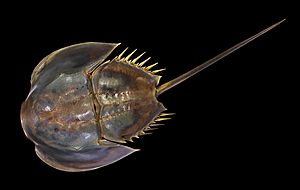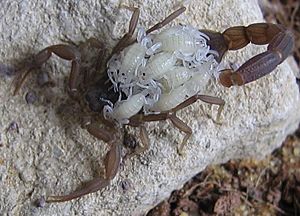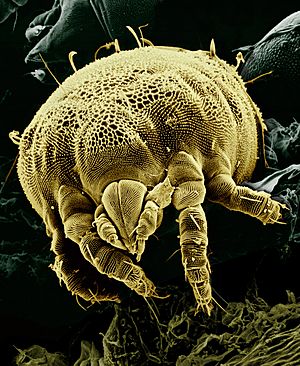Chelicerata facts for kids
Quick facts for kids ChelicerataTemporal range: late Ordovician
445 mya to present (see text) |
|
|---|---|
 |
|
| Horseshoe crab | |
| Scientific classification | |
| Kingdom: |
Animalia
|
| Phylum: |
Arthropoda
|
| Subphylum: |
Chelicerata
|
| Classes | |
|
|
The Chelicerata (say: keh-LISS-er-AH-tah) are a big group of arthropods. Arthropods are animals with jointed legs and a hard outer shell, like insects and crabs. Chelicerates include well-known animals like spiders, scorpions, and ticks. They also include less common ones like horseshoe crabs.
This group gets its name from special mouthparts called chelicerae. These are usually pincers or fangs used for feeding.
Chelicerates first appeared in the ocean about 445 million years ago. Today, most chelicerates live on land and breathe air. There are over 77,000 known species, and scientists think there might be many more waiting to be discovered!
Some animals, like sea spiders, might also be chelicerates. Scientists are still debating this, as their genes suggest they might be a very old, separate group of arthropods. There are about 1,300 species of these 'sea spiders'.
Most chelicerates are carnivores, meaning they eat other animals. But some have different diets, like eating plants or decaying matter.
Contents
What are Chelicerates Like?

Like all arthropods, chelicerates have bodies made of segments and jointed legs. Their bodies are covered by a tough outer layer called a cuticle, which is like a natural suit of armor.
Their bodies are usually divided into two main parts:
- The prosoma (or cephalothorax): This is the front part, which includes the head and chest.
- The opisthosoma: This is the back part, like the abdomen.
The chelicerae are their unique mouthparts. In most chelicerates, they are small pincers used for grabbing food. But in spiders, these chelicerae are fangs that can inject venom into their prey.
Chelicerates have an open circulatory system. This means their blood, called hemolymph, flows freely inside their body cavity, not just in blood vessels. Marine chelicerates breathe using gills. Land-dwelling ones usually have book lungs and tracheae, which are tubes for breathing air.
Their nervous system is usually concentrated in the front part of their body. Most chelicerates use special bristles, called setae, to feel their surroundings. These bristles help them detect touch, vibrations, air currents, and even chemical changes. Some hunting spiders also have very good eyesight.
How Chelicerates Eat
Most modern chelicerates cannot swallow solid food. Instead, they "pre-process" their food outside their bodies. They use their chelicerae and other mouthparts to grind the food. Then, they flood it with digestive chemicals to turn it into a liquid. After that, they can suck up the liquid food.
However, some chelicerates, like harvestmen (also known as daddy longlegs) and horseshoe crabs, can eat solid food. Horseshoe crabs have a unique way of eating: they grab small animals with their leg claws and pass them to their mouth. The bases of their legs have teeth-like parts that grind the food as it moves towards the mouth.
While many chelicerates are predators, some have different diets. For example, some spiders eat nectar and pollen. Many mites and ticks are parasites that suck blood. Others are herbivores (plant-eaters) or scavengers (eating dead things).
How Chelicerates Sense the World
The tough outer shell of chelicerates would block out information from the outside world. But their bodies have many tiny sensors and connections to their nervous system. These sensors are often modified bristles called setae. They can detect different levels of touch, from strong contact to very light air currents. Chemical sensors, often also bristles, help them "taste" and "smell" their environment.
Chelicerates have different types of eyes. Horseshoe crabs have compound eyes on the sides of their heads, which are good at detecting movement. Most other chelicerates have simpler "little eyes" (ocelli) in the middle of their heads. Some spiders, like jumping spiders, have amazing eyesight. Their main eyes are very sharp, allowing them to see colors and even UV light.
Chelicerates and Humans

Chelicerates have interacted with humans in many ways throughout history.
- Horseshoe Crabs: In the past, Native Americans ate horseshoe crabs and used their shells and tail spines for tools. Today, their blood is very important in medicine. It contains a special clotting agent used to test if medicines and medical equipment are free of dangerous bacteria.
- Spiders: In some parts of the world, like Cambodia, cooked tarantulas are eaten as a special food. Scientists are also studying spider venoms for possible medical uses, such as treating heart problems or even some brain diseases. Spider silk is incredibly strong and light, so researchers are trying to produce it using genetic engineering for new materials. While some spider bites can be dangerous, deaths from spider bites are very rare compared to other animal encounters.
- Scorpions: Scorpion stings can be dangerous, especially in less developed countries. However, scientists are also looking into scorpion venom for treating certain cancers and bone diseases.
- Ticks and Mites: Many ticks are parasites that can transmit diseases to humans and animals. Some mites can cause intense itching by biting or burrowing into the skin. Mites are also a big problem for honey bees and can damage crops. However, some predatory mites can be helpful by eating pest mites.
Images for kids
See also
 In Spanish: Chelicerata para niños
In Spanish: Chelicerata para niños



